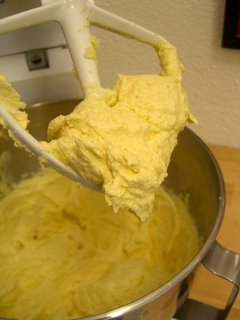Wednesday, February 28, 2007
baking soda
Tuesday, February 27, 2007
can can
Wednesday, February 21, 2007
bagels, take two
- Heat. I increased the heat to 220C from 200C. They're better but I think I can go higher. Next time 230C. I'd prefer to cook shorter time at higher heat so the inside stays moist and the crust gets darker and crisper.
- Flavor. I made them cinnamon raisin this time, adding 2 tsp sugar, 1 tsp cinnamon, and 1/3 cup raisins. (I forgot the vanilla extract recommended by another recipe - I'll try that next time.) After boiling, I sprinkled the top with cinnamon sugar. I served them with cream cheese mixed with my favorite honey. So yum!
Tuesday, February 20, 2007
hot pot, no-knead...
Whatever you call it, I just call it delicious. I finally tried the famous no-knead bread from from Jim Lahey, Sullivan Street Bakery. (Read more about the phenomenon on Slashfood) WOW! Despite my bumbling, it was soooo good - chewy, flavorful, crisp crust, best I ever made. Here's the glamour shot of the wonderful holey structure.
I reviewed numerous blog postings on this recipe before attempting it myself. Based on my reading, I made two modifications to the original recipe: reducing the water to 1 1/2 cups and reducing the cooking time to 20 mins lid on and 20 mins lid off. I checked the internal temp (215F is the desired temp) periodically during the last 15 minutes to make sure I didn't overcook it.
The most important tip I found was from Rose Levy Beranbaum, regarding the transfer of the dough to the hot pot. She shapes and proofs the dough on a silpat sheet so you can just hold the sheet over the hot pot and let it drop off into the pan. This made the transfer super easy. Here are links to her very useful postings on this no-knead bread:
- hot pot bread story in pictures- baby hot pot bread alternative - part 1, part 2
I made one big mistake - wrong pot size. I foolishly used my oval Le Creuset pan, thinking that the dough would magically stretch out into an oval shape. Instead, the hot pot seared the dough immediately into the shape when it hit the pan, thus creating the weirdo shape you see below. Next time I'll search my camping gear for my trusty circular Lodge dutch oven to create a more suitable environment.
Saturday, February 17, 2007
fluffy stuff - sugar cookies
The first trick is rolling out the dough thicker, duh. About 1/4 inch instead of 1/8 inch. My best friend, Leslie, also gave me this advice: "I am a firm believer that the secret to any great homemade cookie is beating up the butter/sugar and eggs/liquids tons until light and fluffy before ever adding any dry ingredients." When I read this, it sounded like standard cookie technique. But based on the wonderful results this time, probably something I hadn't paid enough attention to in the past. Here's a pic of my fluffy stuff, pre-dry stuff:
Thick, Soft Sugar Cookies
makes about 30 cookies
12 TB butter (6oz)
1 cup sugar (7oz)
2 eggs
1 tsp. vanilla
2.5 cups all-purpose flour
1 tsp baking powder
1 tsp salt
- Beat butter and sugar until very light and fluffy. Add eggs and vanilla and beat 2 more minutes. Add dry ingredients and mix until incorporated.
- Chill dough for 1 hour. It’s easier to roll out the dough later if you first shape dough into two disks, about 4 inches in diameter, and then wrap each tightly in plastic wrap. (I don't know if this step is really necessary. Sometimes I immediately roll in parchment and chill from there. I think the chilling is just to make the dough more manageable.)
- Roll & cut. Roll dough thicker than you think you should, approx ¼ inch. The dough warms up very quickly; in about 5 minutes out of the fridge, the dough is a sloppy, buttery mess. So it’s best to roll the dough between parchment paper, then freeze or refrigerate until very cold, then cut very quickly. This technique also prevents the dough from spreading as much in the oven (if bake immediately after cutting), thus preserving more delicate shapes.
- Bake on ungreased sheet at 400F degrees (205C) for about 7 minutes. Remove just before they start to brown, but they no longer look dough-y. Allow to cool briefly on the pan, then transfer to a rack. Frost & decorate & enjoy!
Makes about 1 cup. This is my standard icing for decorating with kids. For a more sophisticated glaze, just thin with milk until desired consistency. Heating the icing supposedly eliminates the raw flavor of the cornstarch in the pwd sugar, while making the icing more creamy and more intensely flavored. You be the judge.
Melt or heat in the top of a double boiler over low heat:
4 TB (2oz) unsalted butter or 3 TB heavy cream
Remove from heat and stir in:
2 cups powdered sugar, sifted if lumpy
3 TB milk
pinch of salt
Cook, stirring occasionally, over barely simmerig water for 5 minutes. Remove from the heat and add:
1 tsp vanilla
Beat until cool and the desired consistency. Keeps for up to 3 days at room temperature, 3 weeks refrigerated, or 6 months frozen.
Tuesday, February 13, 2007
cheerio-o-o
Monday, February 12, 2007
flour redux
After many more hours of internet research since my last flour posting, I'm still as confused as ever about the flour available in Switzerland/Europe. Why can't I buy high protein white flour??? It doesn't make any sense given all the fabulous bread available here. My only guesses are either a) euro flour is different and doesn't need to be high-protein to create highly structured bread or b) high-protein flour is available, but only to professional bakers or c) great mail-order flour sources exist but my terrible german/french/italian google skills are preventing me from finding them. I have a hard time believing hypothesis A or B so I'm hoping to find someone to help me with C. Is there some flour freak out there that can help me? Please!
In the absence of documentation, I'm resorting to manual tests. I started this morning by weighing my various flours (shown above), just to see what I'm dealing with. After doing this, I realized this was pointless, only motived by my sleep-deprived state. But it does provide a nice visual for this posting. I still need to purchase the "typed" flour available at Reformhaus. And I'm also still planning to drive the three hours to France and Italy to buy some of their flour, since apparently no one wants to sell it to me over the internet.
My next project is to make various recipes with different flours to see what happens, comparing structure (tightness of grain), height, and flavor. Here's my plan so far:
sandwich bread
· weissmehl 405, 550, and 812
· zopfmehl
· halbweissmehl
· ruchmehl
ciabatta and pizza dough
· weissmehl 812
· halbweissmehl
· ruchmehl
Random lingering questions:
· What is the difference between regular weissmehl and zopfmehl? The protein level is the same.
· What exactly are halbweissmehl and ruchmehl? I know they are part whole wheat, but what does that mean? What percentage whole grain is in these?
bagel, bagel, who's got the bagel?
Anyway, I tried the bagels with Halbweissmehl, with pleasing results. But there's certainly lots of room for improvement. Here's what I learned today:
- Halbweissmehl at 13g protein provides decent, if not excellent structure. I still may import some high-gluten flour, but I'll keep baking in the meantime.
- My bagel shaping needs serious help. I may try the technique from The Best Recipe, where you roll dough segments into ropes then form into circles, pinching the overlapped ends together. This is bound to make them smoother.
- 200C was not nearly hot enough. After 15 minutes, my little bagels were barely golden. I'm going to try 220C next time.
And now for my bagels story, in pictures:






















